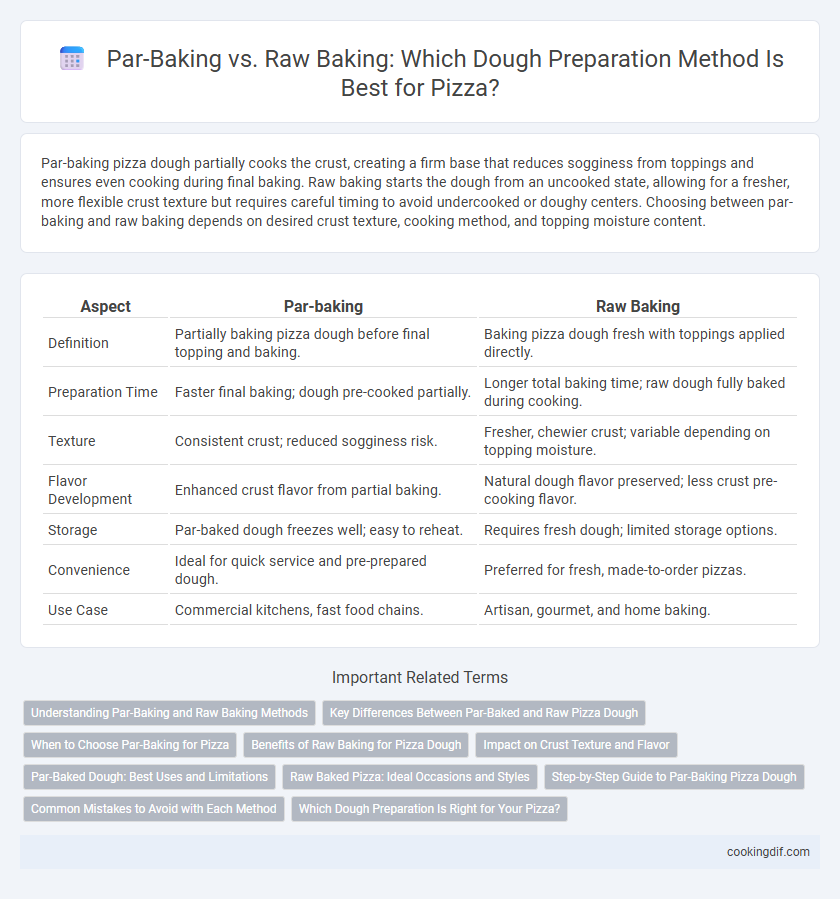Par-baking pizza dough partially cooks the crust, creating a firm base that reduces sogginess from toppings and ensures even cooking during final baking. Raw baking starts the dough from an uncooked state, allowing for a fresher, more flexible crust texture but requires careful timing to avoid undercooked or doughy centers. Choosing between par-baking and raw baking depends on desired crust texture, cooking method, and topping moisture content.
Table of Comparison
| Aspect | Par-baking | Raw Baking |
|---|---|---|
| Definition | Partially baking pizza dough before final topping and baking. | Baking pizza dough fresh with toppings applied directly. |
| Preparation Time | Faster final baking; dough pre-cooked partially. | Longer total baking time; raw dough fully baked during cooking. |
| Texture | Consistent crust; reduced sogginess risk. | Fresher, chewier crust; variable depending on topping moisture. |
| Flavor Development | Enhanced crust flavor from partial baking. | Natural dough flavor preserved; less crust pre-cooking flavor. |
| Storage | Par-baked dough freezes well; easy to reheat. | Requires fresh dough; limited storage options. |
| Convenience | Ideal for quick service and pre-prepared dough. | Preferred for fresh, made-to-order pizzas. |
| Use Case | Commercial kitchens, fast food chains. | Artisan, gourmet, and home baking. |
Understanding Par-Baking and Raw Baking Methods
Par-baking involves partially baking pizza dough before adding toppings, resulting in a crispier crust and faster final bake time, ideal for high-volume operations. Raw baking starts with uncooked dough topped and baked together, producing a chewier texture and allowing flavors to meld during the full bake. Understanding these methods helps pizzerias optimize texture, taste, and preparation efficiency based on customer preferences.
Key Differences Between Par-Baked and Raw Pizza Dough
Par-baked pizza dough is partially cooked before freezing, offering reduced baking times and consistent crust texture, while raw pizza dough is fully uncooked, allowing for fresher taste and customizable crust thickness. Par-baking ensures even cooking and less risk of underbaked centers, making it ideal for quick service, whereas raw dough requires longer baking and closer monitoring to achieve the desired crust quality. The choice between par-baked and raw dough impacts preparation efficiency, shelf life, and overall pizza texture.
When to Choose Par-Baking for Pizza
Par-baking pizza dough is ideal when preparing pizzas in advance to maintain crust texture and prevent sogginess from moist toppings. It offers better control over baking times, ensuring a consistently crisp crust while allowing quick finishing with toppings. Choose par-baking in high-volume settings or for frozen pizzas to streamline preparation and improve quality.
Benefits of Raw Baking for Pizza Dough
Raw baking pizza dough preserves the dough's moisture and texture, resulting in a chewier crust with better oven spring. This method enhances flavor development through natural fermentation, producing a complex, slightly tangy taste. Raw baking also allows for greater control over topping integration, ensuring even cooking and optimal cheese melt.
Impact on Crust Texture and Flavor
Par-baking pizza dough partially cooks the crust, creating a firmer texture that prevents sogginess by reducing moisture during final baking. Raw baking allows for a chewier, airier crust with enhanced fermentation flavors developing fully in the oven. Texture differences are notable: par-baked crusts offer crispness and structure, while raw-baked dough emphasizes softness and complex, slightly tangy taste profiles.
Par-Baked Dough: Best Uses and Limitations
Par-baked dough offers a partially cooked base that provides consistent texture and reduced baking time, making it ideal for busy restaurants and frozen pizza products. It retains a crisp crust while allowing toppings to cook evenly without overbaking the dough. However, par-baked dough can limit customization options and may lack the freshly baked flavor achieved from raw dough baking.
Raw Baked Pizza: Ideal Occasions and Styles
Raw baked pizza dough excels in creating artisanal styles like Neapolitan and New York-style pizzas, where a fresh, soft crust with a slightly chewy texture is desired. Ideal occasions for raw baking include home-cooked meals and gourmet pizzerias that emphasize authentic, made-from-scratch flavors. This method allows for precise control over crust thickness and toppings integration, enhancing the overall pizza experience.
Step-by-Step Guide to Par-Baking Pizza Dough
Par-baking pizza dough involves partially baking the dough at around 450degF (232degC) for 4-6 minutes to develop a firm crust that prevents sogginess during topping application. Begin by rolling out the dough to the desired thickness, dock it with a fork to avoid bubbles, then bake on a preheated pizza stone or baking sheet until the surface is set but not browned. This technique ensures a crispier base and faster final baking when toppings are added, compared to raw baking where the dough is cooked fully with toppings from the start.
Common Mistakes to Avoid with Each Method
Par-baking pizza dough often leads to dryness and uneven texture if not timed precisely, as premature baking hardens the crust before toppings are added. Raw baking mistakes include underproofing, which causes dense crusts, and excessive oven temperature, resulting in burnt edges and a raw interior. Ensuring proper hydration levels and temperature control during fermentation crucially impacts elasticity and flavor development in both methods.
Which Dough Preparation Is Right for Your Pizza?
Par-baking pizza dough involves partially baking the crust before adding toppings, resulting in a crispier base and reduced cooking time when finished. Raw baking starts with uncooked dough, allowing the crust to fully bake with the toppings, yielding a chewier texture and more integrated flavors. Choosing the right method depends on desired crust texture, cooking equipment, and preparation time available.
Par-baking vs Raw baking for dough preparation Infographic

 cookingdif.com
cookingdif.com